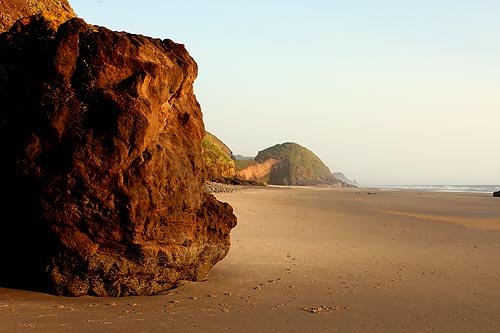 |
Winter Solstice Science: How It's Different on Oregon Coast
Published 12/18/2014

(Oregon Coast) – You won't get to see it in Oregon because of all the thick rain this weekend, but sunset will be doing some interesting things on Sunday with the shortest day of the year and the official beginning of winter.
The winter solstice is an intriguing bundle of fun facts – scientifically, culturally and for those studying history. Sunsets are longer, colors can be more intense – and there's a fascinating secret about how this day is different on the Oregon coast.
This time around, it happens on Sunday, December 21, and in Oregon it means that 3:03 p.m. brings the official change between fall and winter.
On this day, the Earth's northern pole is tipped away from the sun, according to OMSI planetarium manager Jim Todd.
“At that moment the sun, in the constellation of Sagittarius, sits over the Tropic of Capricorn at latitude of 23.5 degrees south,” Todd said.
Todd said that Portlanders will see the sun reach its lowest southern point in the sky at 21 and a half degrees on the horizon. Because of the low angle of the sun's arc, it will produce the longest and most spectacular sunrises and sunsets of the year. On December 18-21, the area will have a mere 8.5 hours of daylight to enjoy.
For the Oregon coast, this would mean longer sunsets and wilder colors – if it wasn't for the heavy cloud layers. Sunday is expected to be one of the nastiest rain storms along the coast in a long time.
However, don't be surprised to be surprised: even the cloudiest days on the coast can produce a few moments of unexpected sun at times.
If the sun were showing that day, you would notice a few extra minutes of light along the Oregon coast. At 75 miles to the west of Portland, places like Cannon Beach, Seaside or Manzanita actually experience a slightly later sunset than inland.
When the Almanac says sunset in Portland is at a certain time, it happens about seven minutes later on the beaches. Oregon Coast Beach Connection staff discovered that in its own experiment two years ago, when they clocked the sun going down below the horizon right at 9:10 p.m., exactly seven minutes later than the time scheduled for Portland's sunset.
This again brings up an interesting point, which Todd helped explain. Do sunset predictions take into account things like mountains, hills or cityscapes?
“They are talking about the true horizon, where it is zero degrees,” Todd said.
True horizon means they are referring to a landscape with nothing blocking the view. Zero degrees is where the horizon would be on an exactly flat plane, Todd explained.
The Oregon coast is where you can witness just that kind of flat landscape – or in this case, seascape.
The end of twilight is defined as when the sun dips 18 degrees below the horizon. Todd said this point is reached more quickly in the summer than in the winter, again because of the arc of the sun. More Oregon Coast Science
More About Oregon Coast hotels, lodging.....
More About Oregon Coast Restaurants, Dining.....
LATEST Related Oregon Coast Articles
Whale Body Parts Found on Oregon Coast - Two Whales Strand on Washington Coast |
Back to Oregon Coast
Contact Advertise on BeachConnection.net
All Content, unless otherwise attributed, copyright BeachConnection.net Unauthorized use or publication is not permitted
Secrets of the Season |
Unusual Travel Articles TravelParanormal.com allows you to submit your own creepy tale or debunk one - or see up-to-the-minute news headlines about travel and the paranormal. News Headlines from All Over Oregon Need to scan Oregon headlines? Constantly updated news from all over Oregon: a comprehensive, up-to-the-minute display of news headlines from a variety of media Oregon Coast Oceanfront Lodging, Hotels, Rentals |









































